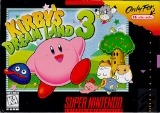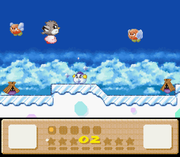
Kirby's Dream Land 3
Encyclopedia
Kirby's Dream Land 3, known as in Japan, is the fifth platformer
video game starring Kirby
. Specifically, it is the third game under the Kirby's Dream Land name. Although the first two games were largely unrelated, Dream Land 3 features many similar characters to Dream Land 2
. Kirby 64: The Crystal Shards
was the sequel to this game.
Kirby's Dream Land 3 is the last first party game released for the Super NES
in North America
, although it is not the final game for the system (the 1998
Super NES version of Frogger
would be the final game in North America
, while the 2000
Super Famicom remake of Metal Slader Glory
was the final game in Japan
). Problems with the game's PAL conversion prevented it from being released in Europe and Australia for many years; it was finally released in those regions in the form of an import from North America on July 24, 2009. The game was re-released on the Virtual Console
in North America on January 5, 2009 and in Japan on April 28, 2009.
, or swallowed. Normally this has no effect on Kirby, although specific enemies grant Kirby copy abilities, a staple of the Kirby games. Copy abilities replace Kirby's standard inhaling move with a special attack, depending on the enemy Kirby ate. For example, swallowing a fire-based enemy allows Kirby to become a fireball.
 At any time during play, Kirby can summon Gooey—a blue, long-tongued blob first seen in Dream Land 2. Doing so costs Kirby two hit points. When controlled by the computer, Gooey follows Kirby around and helps him to defeat enemies. (Gooey can also be controlled by a second human player.) Gooey's abilities are similar to Kirby's: He can swallow enemies using his long tongue, then either spit them out or copy their abilities to a limited extent. Kirby can also inhale Gooey and swallow him, reclaiming his two hit points.
At any time during play, Kirby can summon Gooey—a blue, long-tongued blob first seen in Dream Land 2. Doing so costs Kirby two hit points. When controlled by the computer, Gooey follows Kirby around and helps him to defeat enemies. (Gooey can also be controlled by a second human player.) Gooey's abilities are similar to Kirby's: He can swallow enemies using his long tongue, then either spit them out or copy their abilities to a limited extent. Kirby can also inhale Gooey and swallow him, reclaiming his two hit points.
In addition to Gooey, Kirby can team up with any one of his six other friends, three of which were introduced in the previous game in the series
. This friend mechanic allows Kirby to be ridden, carried or rolled, enabling new team-based abilities, as well as variations of Kirby's copy abilities.
The cartridge also takes advantage of SA-1 technology to process game data at a faster rate, which was necessary for the large number of bitmaps and special effects used by faster releases.
. But once you get past that, you can appreciate Dream Land 3 for what it is -- a direct, numbered follow-up to the series that started on the Game Boy
."
Platform game
A platform game is a video game characterized by requiring the player to jump to and from suspended platforms or over obstacles . It must be possible to control these jumps and to fall from platforms or miss jumps...
video game starring Kirby
Kirby (Nintendo)
is the main protagonist of Nintendo's Kirby video game series created by Masahiro Sakurai and developed by HAL Laboratory. The Kirby series is one of Nintendo's many well-known game franchises, spanning nearly twenty games since 1992...
. Specifically, it is the third game under the Kirby's Dream Land name. Although the first two games were largely unrelated, Dream Land 3 features many similar characters to Dream Land 2
Kirby's Dream Land 2
Kirby's Dream Land 2, known as in Japan, is a platforming video game developed by HAL Laboratory and published by Nintendo for the Game Boy handheld video game console...
. Kirby 64: The Crystal Shards
Kirby 64: The Crystal Shards
Kirby 64: The Crystal Shards, known as in Japan, is a platform game developed by HAL Laboratory and published by Nintendo for the Nintendo 64...
was the sequel to this game.
Kirby's Dream Land 3 is the last first party game released for the Super NES
Super Nintendo Entertainment System
The Super Nintendo Entertainment System is a 16-bit video game console that was released by Nintendo in North America, Europe, Australasia , and South America between 1990 and 1993. In Japan and Southeast Asia, the system is called the , or SFC for short...
in North America
North America
North America is a continent wholly within the Northern Hemisphere and almost wholly within the Western Hemisphere. It is also considered a northern subcontinent of the Americas...
, although it is not the final game for the system (the 1998
1998 in video gaming
-Events:*Academy of Interactive Arts & Sciences hosts 1st Annual Interactive Achievement Awards; inducts Shigeru Miyamoto of Nintendo to the AIAS Hall of Fame*British Academy of Film and Television Arts hosts the 1st annual BAFTA Interactive Entertainment Awards...
Super NES version of Frogger
Frogger
Frogger is an arcade game introduced in 1981. It was developed by Konami, and licensed for worldwide distribution by Sega/Gremlin. The object of the game is to direct frogs to their homes one by one. To do this, each frog must avoid cars while crossing a busy road and navigate a river full of...
would be the final game in North America
North America
North America is a continent wholly within the Northern Hemisphere and almost wholly within the Western Hemisphere. It is also considered a northern subcontinent of the Americas...
, while the 2000
2000 in video gaming
-Events:* May 11–13 — 6th annual Electronic Entertainment Expo ; the 3rd annual Game Critics Awards for the Best of E³* June 26 — International Game Developers Association renamed from Computer Game Developers Association...
Super Famicom remake of Metal Slader Glory
Metal Slader Glory
is a science-fiction-themed graphic adventure game developed by HAL Laboratory that was released for the Family Computer exclusively in Japan on August 30, 1991. It was the final game released by HAL Laboratory as an independent third-party developer before their buy-out by Nintendo...
was the final game in Japan
Japan
Japan is an island nation in East Asia. Located in the Pacific Ocean, it lies to the east of the Sea of Japan, China, North Korea, South Korea and Russia, stretching from the Sea of Okhotsk in the north to the East China Sea and Taiwan in the south...
). Problems with the game's PAL conversion prevented it from being released in Europe and Australia for many years; it was finally released in those regions in the form of an import from North America on July 24, 2009. The game was re-released on the Virtual Console
Virtual console
A virtual console – also known as a virtual terminal – is a conceptual combination of the keyboard and display for a computer user interface. It is a feature of some operating systems such as UnixWare, Linux, and BSD, in which the system console of the computer can be used to switch between...
in North America on January 5, 2009 and in Japan on April 28, 2009.
Gameplay
The game's platforming mechanics are very similar to most other Kirby games, as is Kirby's skillset. Kirby is able to jump, duck, slide, fly (by inflating himself), as well as perform his signature move: inhaling enemies. When Kirby inhales an enemy, it can be spit back out as a projectileProjectile
A projectile is any object projected into space by the exertion of a force. Although a thrown baseball is technically a projectile too, the term more commonly refers to a weapon....
, or swallowed. Normally this has no effect on Kirby, although specific enemies grant Kirby copy abilities, a staple of the Kirby games. Copy abilities replace Kirby's standard inhaling move with a special attack, depending on the enemy Kirby ate. For example, swallowing a fire-based enemy allows Kirby to become a fireball.
Kirby's allies

In addition to Gooey, Kirby can team up with any one of his six other friends, three of which were introduced in the previous game in the series
Kirby's Dream Land 2
Kirby's Dream Land 2, known as in Japan, is a platforming video game developed by HAL Laboratory and published by Nintendo for the Game Boy handheld video game console...
. This friend mechanic allows Kirby to be ridden, carried or rolled, enabling new team-based abilities, as well as variations of Kirby's copy abilities.
Visuals
Kirby's Dream Land 3 uses a mode of the SNES termed "pseudo high-resolution" (which allows for color blending between two adjacent pixels) to blend dithered sprites.The cartridge also takes advantage of SA-1 technology to process game data at a faster rate, which was necessary for the large number of bitmaps and special effects used by faster releases.
Reception
Kirby's Dream Land 3 received mixed reception from both critics and fans. IGN gave Dream Land 3 a fairly positive review of the Virtual Console re-release, "It's not Super StarKirby Super Star
Kirby Super Star, known as Kirby's Fun Pak in Europe and as in Japan, is a 1996 platforming video game developed by HAL Laboratory and published by Nintendo for the Super Nintendo Entertainment System video game console. It was first released in Japan on March 21, 1996, in North America on...
. But once you get past that, you can appreciate Dream Land 3 for what it is -- a direct, numbered follow-up to the series that started on the Game Boy
Game Boy
The , is an 8-bit handheld video game device developed and manufactured by Nintendo. It was released in Japan on , in North America in , and in Europe on...
."
External links
- Kirby's Dream Land 3 Profile - Nintendo (Archive)
- Kirby's Dream Land 3 at Moby Games
- Kirby's Dream Land 3 at IGNIGNIGN is an entertainment website that focuses on video games, films, music and other media. IGN's main website comprises several specialty sites or "channels", each occupying a subdomain and covering a specific area of entertainment...

